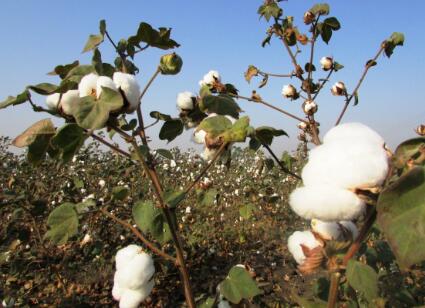How to grow cotton? What are the high-yield technologies?
Cotton is an annual herb of cotton genus of Malvaceae, and it is one of the most important cash crops in the world. Cotton planting has a high planting value, so how to grow cotton? The following is to introduce the high-yield planting techniques of cotton, let's learn about it.

I. planting conditions of cotton
1. Light condition: cotton is a light-loving crop, which is suitable to grow under sufficient light conditions. the light compensation point and light saturation point of single leaf of cotton are high. According to the determination, the light compensation point of single leaf of cotton is 75-1000 lux, and the light saturation point is 70-80 thousand lux. in general, the suitable range of cotton leaf for light intensity is 8000-70000 lux, and the photosynthetic intensity increases with the increase of light intensity.
two。 Water conditions: cotton growth needs to absorb water from the soil, and the physiological water requirements are different at different growth stages. The soil water content of 0-20 cm from sowing to seedling emergence accounts for 70-80% of the field capacity. The water content of 0-40 cm soil layer accounts for 60-70% of the field capacity at seedling stage, and 65-75% of field capacity at early bud stage. After the full bud stage, the water content of the 0-80 cm soil layer accounts for 70-80% of the field capacity, not less than 60-65%, and the relative soil water content during the boll-opening period should be kept at 55-70%. According to the relevant research, in the whole growth period of cotton field, about 2 × 3 of water is consumed by transpiration and 1 of which is consumed by land evaporation.
3. Soil conditions: cotton growth and development needs water and nutrients, mainly obtained from the soil through the root system, the required temperature and air are partly taken from the soil, and need the mechanical support of the soil to grow. The physical, chemical and biological properties of soil in cotton field restrict the yield and quality of cotton to a great extent. soil moisture, nutrients, temperature, air, saline-alkali content and texture have great influence on the growth of cotton.
4. Heat condition: the early and late stages of cotton growth are the most sensitive to heat conditions. It takes 7-20 days from sowing to emergence, and the active accumulated temperature is 160320 ℃. When the temperature is above 20 ℃ after sowing, the cotton seedlings can emerge in 7-8 days. If the temperature is unstable after sowing, although the average temperature is 15-17 ℃, it will take about 20 days for seedlings to emerge. The lower the daily average temperature, the more accumulated temperature is needed from sowing to emergence. The heat condition from flowering to boll opening stage not only affects cotton yield, but also seriously affects cotton quality. in the same region and the same variety, when the interval between flowering and boll opening stage is obviously prolonged, the accumulated temperature is too much in this stage. the yield and quality of cotton decreased significantly.
II. Planting techniques of cotton
1. Preparation before sowing: the purchase of improved cotton varieties is recommended to change seeds every year, do not be cheap, use the second or third generation of cotton seeds, because the output of self-retained seeds is reduced by about 10% every year. Use about 1.5 kilograms of seeds per mu, dry the seeds before sowing, the cumulative drying time is not less than 30 hours, and constantly turn over. Be careful not to spread it directly on the cement floor, brick floor or metal plate. Before sowing, the soil moisture must be made and preserved in time, so that the soil moisture can be planted.
two。 Fertilization and sowing: generally apply 3-4 square of high quality farm manure, 10 kg of urea, 20 kg of diammonium, 20 kg of potassium sulfate compound fertilizer and 2 kg of boron, zinc, manganese, iron and other micro-fertilizers. Sowing prematurely will result in incomplete emergence of seedlings, aggravation of diseases in seedling stage and premature senescence in later stage due to low temperature. Too late is easy to cause overgrowth, sitting peach on the upper side, missing the best boll period, which is not conducive to high yield. The best sowing date is about April 20, and the sowing depth is about 3 centimeters. According to the soil moisture, the soil moisture is slightly shallower than the clay soil, and the soil moisture is slightly deeper than the sandy soil.
3. Reasonable close planting: sand, poor fertility of the appropriate close planting, clayey soil, good fertility of the appropriate sparse planting, the recommended practice is to plant large and small rows of about 1 meter, small rows of 55 centimeters, plant spacing of about 40 centimeters. When planting with tractor plastic film mulching, there are now a considerable number of cotton farmers who leave too many seedlings at seedling stage, early closure of cotton lines, poor ventilation and light transmission, resulting in reduced photosynthesis, serious shedding of buds and bolls, aggravation of cotton diseases and insect pests, and increase of ineffective branches, which is not conducive to field operation. the yield and quality of cotton are reduced, affecting income.
4. Topdressing watering: generally without watering at the seedling stage, 20 kg of urea per mu at the flower and boll stage, and about 15 days of drought at the early flowering stage. At noon, the leaves should be watered in time when they wilt slightly, even if it rains and is not permeable. Finally, after cotton bolls are opened, they should also be watered once in case of drought, which can improve root vitality, delay cotton senescence, increase boll weight, and increase yield by about 10%.
5. Chemical control and topping: the scientific use of Jiaoan and Zhuangzhu is the key measure to build a high-yield shelf to achieve high yield. Chemical control begins at the budding stage, 0.5 grams per mu for 6-8 leaves, 1.5 grams per mu for early flowering, and 3 grams per mu after topping. Master the principle of "light in front and heavy in back, a small number of times". To hit the top, you should master "time to wait for branches, branches to see the growth", the general cotton field will be completed on July 15-20.
6. Pest control: Tian Da 2116 plus carbendazim plus imidacloprid can be used in the seedling stage, and carbendazim is added to sterilize every time. Phoxim, malathion, cypermethrin, avermectin and other pesticides are used alternately to control cotton bollworm, blind Toona sinensis, red spider, etc., and potassium dihydrogen phosphate, urea and micro-fertilizer are added alternately at the same time of spraying.
Time: 2019-03-19 Click:
- Prev

When do small trees usually bloom? How long is the flowering period? How much does a seedling cost? planting method
Purple leaf plum alias red leaf plum, cherry plum, rose family plum is deciduous small tree, up to 8 meters high, native to southwest Asia, perennial purple leaves, famous leaf species. When do purple-leaf plums usually bloom? How long is the flowering period? How much does a seedling cost? What are the planting methods?
- Next

How many years do coral beans usually live? How do you plant seeds? Can I put it in the bedroom? What if the leaves turn yellow?
Coral beans, also known as coral cherry, winter coral, jade coral, coral son, jujube, birthday fruit, exuberant growth, strong adaptability, reproduction and cultivation are easy, commonly used sowing reproduction. How many years do coral beans usually live? How do you plant seeds? Can I put it in the bedroom? What if the leaves turn yellow? Learned from the grower Uncle Gao
Related
- Fuxing push coffee new agricultural production and marketing class: lack of small-scale processing plants
- Jujube rice field leisure farm deep ploughing Yilan for five years to create a space for organic food and play
- Nongyu Farm-A trial of organic papaya for brave women with advanced technology
- Four points for attention in the prevention and control of diseases and insect pests of edible fungi
- How to add nutrient solution to Edible Fungi
- Is there any good way to control edible fungus mites?
- Open Inoculation Technology of Edible Fungi
- Is there any clever way to use fertilizer for edible fungus in winter?
- What agents are used to kill the pathogens of edible fungi in the mushroom shed?
- Rapid drying of Edible Fungi

